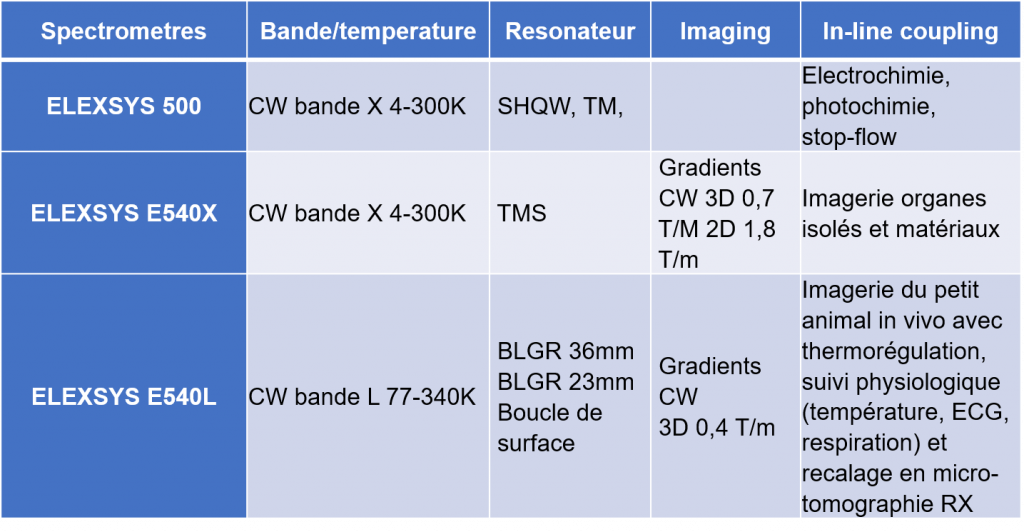EPR
Staff
Platform Activity
Why do EPR, EPR imaging?
EPR is the method of choice for the detection of paramagnetic species (dioxygen, radicals of oxidative stress, NO, endogenous radicals, radicals resulting from exposure to ionizing radiation, metalloenzymes, transition metal complexes, etc.).
The EPR allows:
- characterizing and monitoring paramagnetic species and quantifing or evaluating a variation in the amount of these species;
- characterizing radical mechanisms;
- evaluating the ability of a molecule to trap radicals.
EPR imaging is a method of molecular imaging that allows the mapping of paramagnetic species in an object or an animal. We were the first to reposition our EPR molecular images on anatomical images obtained using an RX microtomograph.
Presentation of the operation of the RPE spectroscopy and imaging platform
Since January 1st, 2011, we belong to the TGE RENARD federation “National Network of RPE interDisciplinaire” and we welcome as such external research teams, academic or private, interested in our expertise in spectroscopy and imaging paramagnetic electronic resonance more specifically in the field of biomedical applications.
In general, the procedure for initiating a project is as follows:
We encourage you to submit your project on the TGE RENARD website by filling out the dedicated form. We will then be notified of your request and we will agree together on a first meeting to launch the project. Alternatively, if you contact us directly, you will need to complete the TGE form after discussing the project with us at a first meeting.
Preliminary experiments are carried out to verify the feasibility of the study. Your presence is necessary during these tests, especially if they are in vivo experiments.
We then agree on a protocol to follow in order to clearly identify the objectives and costs of the project. Pricing is dependent on the type of experiences and your status.
Follow-up meetings are scheduled regularly to discuss the results and progress of the project.
Practical information on how to access the platform
Conditions of access to the platform
The platform is not freely accessible because the use of the devices requires a good knowledge of spectroscopy. In addition, EPR imaging is an emerging imaging modality, the majority of applications are not yet routine and requires the development of a specific protocol. However, when the skills of users and the duration of the project allow, it is possible to work independently.
Health status
The health status over the last three months is required before any examination, except for animals from approved breeders, delivered directly to the platform, for which the health certificate provided is sufficient.
GMO declaration
For any study, the approval of the Commission of Genetic Engineering (or transiently the declaration of the laboratory to this Commission) will be requested.
Project authorization using animals
In the case of projects requiring the use of animals, an application for a project authorization must be drafted in collaboration and be filed with the ethics committee of the Paris Descartes University and the Ministry of Research. Experiments can only begin after the project has been approved.
Useful link: CNRS-SDV: animal experimentation

EPR
Staff


Yves Frapart
Senior Engineer, HDR
Contact:
01 42 86 38 82
Sonia Lajnef
Engineer
Contact:
01 42 86 21 75
Description
Platform Activity
Why do EPR, EPR imaging?
EPR is the method of choice for the detection of paramagnetic species (dioxygen, radicals of oxidative stress, NO, endogenous radicals, radicals resulting from exposure to ionizing radiation, metalloenzymes, transition metal complexes, etc.).
The EPR allows:
- characterizing and monitoring paramagnetic species and quantifing or evaluating a variation in the amount of these species;
- characterizing radical mechanisms;
- evaluating the ability of a molecule to trap radicals.
EPR imaging is a method of molecular imaging that allows the mapping of paramagnetic species in an object or an animal. We were the first to reposition our EPR molecular images on anatomical images obtained using an RX microtomograph.
Presentation of the operation of the RPE spectroscopy and imaging platform
Since January 1st, 2011, we belong to the TGE RENARD federation “National Network of RPE interDisciplinaire” and we welcome as such external research teams, academic or private, interested in our expertise in spectroscopy and imaging paramagnetic electronic resonance more specifically in the field of biomedical applications.
In general, the procedure for initiating a project is as follows:
We encourage you to submit your project on the TGE RENARD website by filling out the dedicated form. We will then be notified of your request and we will agree together on a first meeting to launch the project. Alternatively, if you contact us directly, you will need to complete the TGE form after discussing the project with us at a first meeting.
Preliminary experiments are carried out to verify the feasibility of the study. Your presence is necessary during these tests, especially if they are in vivo experiments.
We then agree on a protocol to follow in order to clearly identify the objectives and costs of the project. Pricing is dependent on the type of experiences and your status.
Follow-up meetings are scheduled regularly to discuss the results and progress of the project.
Practical information on how to access the platform
Conditions of access to the platform
The platform is not freely accessible because the use of the devices requires a good knowledge of spectroscopy. In addition, EPR imaging is an emerging imaging modality, the majority of applications are not yet routine and requires the development of a specific protocol. However, when the skills of users and the duration of the project allow, it is possible to work independently.
Health status
The health status over the last three months is required before any examination, except for animals from approved breeders, delivered directly to the platform, for which the health certificate provided is sufficient.
GMO declaration
For any study, the approval of the Commission of Genetic Engineering (or transiently the declaration of the laboratory to this Commission) will be requested.
Project authorization using animals
In the case of projects requiring the use of animals, an application for a project authorization must be drafted in collaboration and be filed with the ethics committee of the Paris Descartes University and the Ministry of Research. Experiments can only begin after the project has been approved.
Useful link: CNRS-SDV: animal experimentation


